The World of Dizzy: A Fantastic Adventure
A look at the world created in "The Fantastic Adventures of Dizzy" ("Fantastic Dizzy") for the NES.

This is a reblog of a post on my blog at gamemakeworld.wordpress.com.
Fantastic Dizzy/The Fantastic Adventures of Dizzy (depends on your region- I’ll call it Dizzy) was developed by Codemasters and released for the NES in 1991.
WORLDVIEW: The joy of discovering and collecting items.
THEME: Strolling through an a bright & cheerful, ever-unfolding world.
Dizzy (which is also the name of the main character) trains you to scan the screen for three types of objects: puzzle items, stars, and fruits, which are cause for excitement/curiosity, a sense of accomplishment, and a sense of relief, respectively. You must plan your journey around these objects in order to unlock new areas and advance through the game.
VISUALS
Each area has a distinct theme and style, from the cheerful treehouse village, to the dark cavern, to the bright beach. Graphics are simple, clear, and colorful.

Fig. 1: The Yolkfolk Treehouse Village just outside Dizzy’s house

Fig. 2: Dizzy snuck past the sleeping dragon!
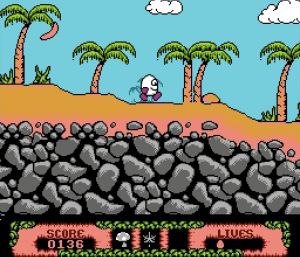
Fig. 3: Dizzy walks along the beach.
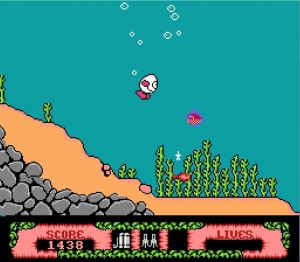
Fig. 4: Flippers and an oxygen tank enable Dizzy to swim.
In an interesting twist, you end up scanning each colorful area for small, gray, sometimes unreadable objects. These are the puzzle items, crucial for advancing in the game. Spotting a new one is an exciting discovery, and successfully discovering how to use one a delight.
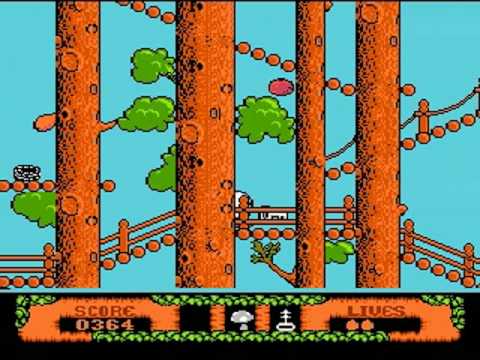
Fig. 5: Gray items and fruits dot the village landscape.
Puzzle items pop into color when used appropriately, usually unlocking your path or opening up a new area. Their change in color, as if they are springing to life, adds to the delightful burst of dopamine that comes along with solving a puzzle.
Overall, the graphics are detailed and impressive for an NES game- Dizzy has various facial expressions as well as an idle animation.
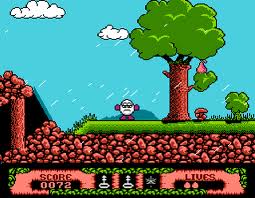
Fig. 8: The rain makes Dizzy feel sad.
And the sky even fades from day to night as time goes by: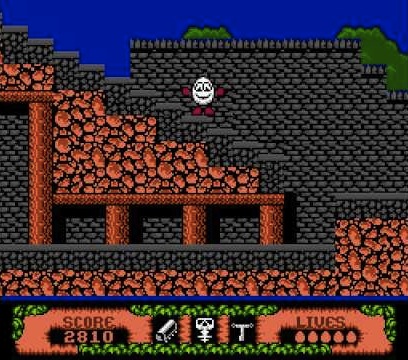
Fig. 9: Evening falls upon the village of Keldor.

Fig. 10: Things get spooky in the dead of night below the Yolkfolk village.
As for the characters, there are only a few, so each one- and their related quest- feels important.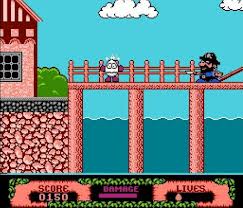
Fig. 11: The pirate Blackbeard will block your path (and attack you if you come too close) until he receives a certain item.
Personally, I’ll always have a softspot for the Yolkfolk Treehouse Village. The idea of egg-shaped characters who live in the trees is amusing and original, giving the game a unique charm.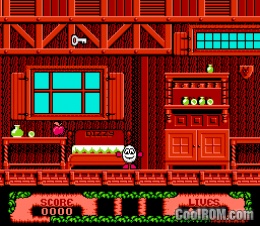
Fig. 6: Dizzy at home, where the game begins
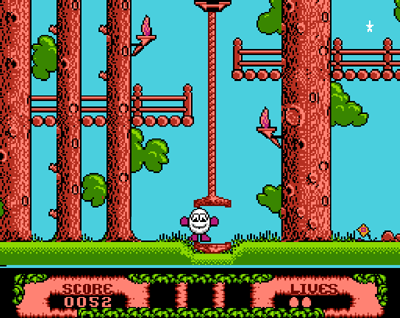
Fig. 7: The elevator to the Yolkfolk Treehouse Village
TEXT
The menu screen resembles a piece of parchment with more realistic, full color depictions of items and textual description. Though it is sharply different in style than the rest of the game, its hint of realism inspires the imagination and gives clues as to how to use items.
Besides the item descriptions in the menu, the only in-game text occurs in full screen windows when you talk to Yolkfolk or solve their puzzles. This helps make the characters feel important and their quests feel like major accomplishments in the course of the game.
RULES & GOALS
The world scrolls out in both directions as you travel (you can also go up in some cases), eventually looping around to form one continuous world. When you reach a certain point your progress is usually blocked until you solve a puzzle and unlock a new path, room, or area.
Considering how open-ended it is, collecting stars gives a sense of progress- when you see a star, you know you’re going in the right direction and one step closer to the end of the game. Their countdown provides a linear yardstick to measure how you are doing.
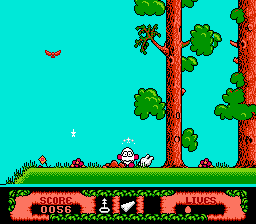
Fig. 12: A star and a roast chicken item
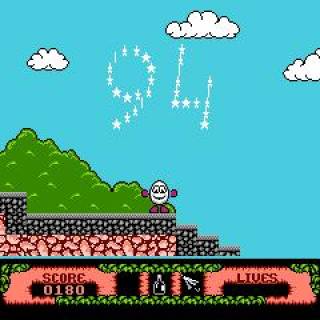
Fig. 13: Only 94 stars left before Dizzy can enter the evil wizard Zaks’ castle in the clouds!
Dizzy takes damage from drops of water and animals, but his damage meter can be reduced by eating fruit. This makes any fruit you spot a delightful relief that makes you feel safe.

Fig. 14: A slice of watermelon to ease your hardships in Keldor Castle
CONTROLS
Dizzy’s controls are simple- you can walk, jump or use/pick up an item. There is no running, or even any control over the length and height of his jumps.
Thus, except for the few mini-games and difficult jumps, there is very little fast-paced button mashing. It is mainly a matter of knowing when and where to use items, and planning which three items to carry at any given time.
SOUND
The songs are varied and memorable. I especially like Yolkfolk Village Indoors, Keldor Village 1 and 2, and Underwater). Overall, the music effectively sets distinct tones and strong moods for each area.
Sound effects are near non-existent, but the sound and animation when eating fruit made it feel very nourishing.
WHAT COULD BE BETTER
I was never able to beat the game due to the lack of a save feature. However, gradually learning the location and use of each item through many replays and then planning accordingly is fun in a way that would be lost if you only had to solve each puzzle once. At the same time, the game is too massive for anyone to beat without many consecutive hours to spare, careful planning, and mastery of every mini-game and difficult jump.
Speaking of jumps, Dizzy’s tendency to roll after jumps leads to a lot of accidental deaths and frustration. Granted, I was probably 12 the last time I played, but reviews online agree about the game’s difficulty in places.
SUMMARY
Graphics: Bright, colorful, and clear, yet in a delicious twist your attention is focused on small black-and-white objects, which are key to unlocking your path. Very detailed graphics and animations for the era.
Rules & Goals: Rules focus your attention on gathering three types of items: stars, fruits, and puzzle items. They become meaningful and delightful to discover, collect, and use.
Sound: Varied and catchy, setting distinct moods for each area.
Controls: Simple and fun, but lack of control over jumps and unpredictable rolling can lead to frustration.
Text: Virtually none except during a few character-related events where bursts of text add an extra sense of accomplishment to puzzles. Item descriptions on the menu screen provide hints and amusement.
Fantastic Dizzy/The Fantastic Adventures of Dizzy shows impressive size, quality, and attention to detail for its time. Through it’s combination of platforming and puzzle-solving, it focuses the player on the delights of discovering, collecting, and successfully using items. Dizzy is an object-oriented stroll through a bright, varied, and charming world that gradually unfolds before you as you solve its puzzles.
Read more about:
BlogsAbout the Author(s)
You May Also Like












